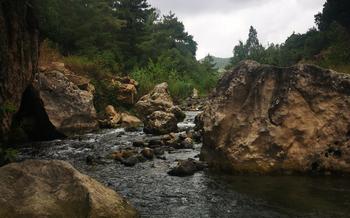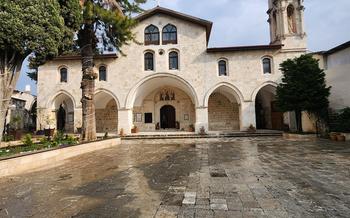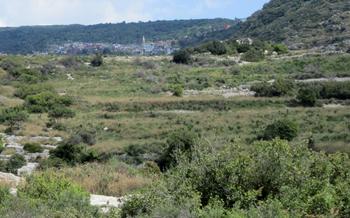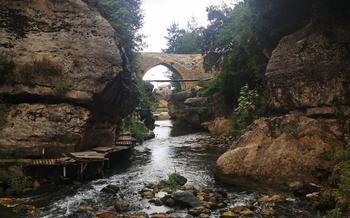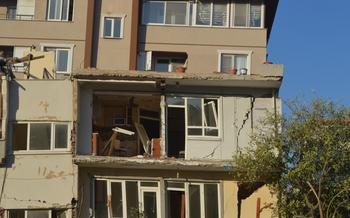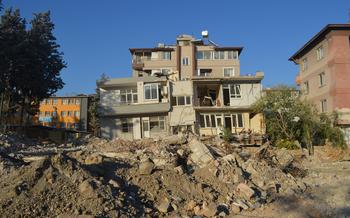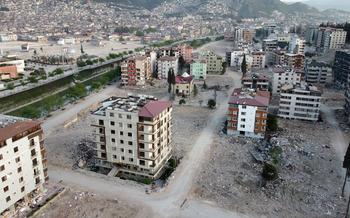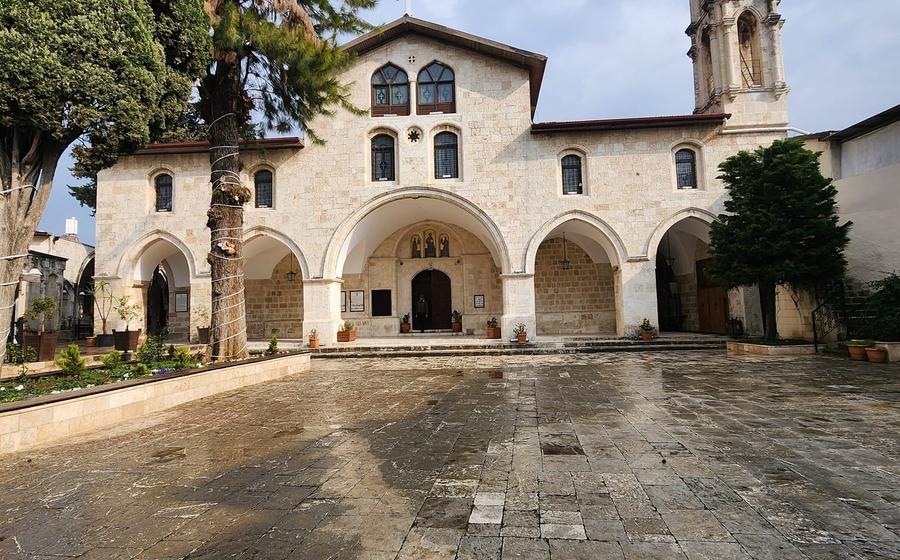
St. Paul Orthodox Church
- History and Cultural Significance of St. Paul Orthodox Church
- Location and Accessibility
- Cultural Artifacts
- Religious Ceremonies
- Community Involvement
- Pilgrimage Site
- Symbol of Tolerance
- Educational Opportunities
- Photography and Videography
- Appropriate Attire
- Local Cuisine
- Nearby Attractions
- Insider Tip: Experience the Serenity of Early Morning Visits
History and Cultural Significance of St. Paul Orthodox Church
St. Paul Orthodox Church holds a significant place in the history of Christianity in Turkey, particularly in the southeastern province of Hatay. Founded in the 19th century by the Greek Orthodox community, the church serves as a testament to the rich cultural heritage of the region. Its architectural style, a blend of Byzantine and Ottoman influences, reflects the harmonious coexistence of different cultures in Hatay. The church stands as a symbol of religious tolerance and serves as a reminder of the importance of preserving diverse religious traditions.
Location and Accessibility
The St. Paul Orthodox Church is situated in the heart of Hatay, Turkey, a city steeped in history and cultural diversity. To reach this sacred site, visitors can conveniently utilize public transportation or embark on a scenic drive using private vehicles. The church is easily accessible from the city center, with regular bus routes that stop nearby. For those driving, ample parking is available in the vicinity, ensuring a hassle-free visit.
When planning your journey to the church, consider combining your visit with other nearby attractions that showcase Hatay's rich heritage. The Hatay Archaeology Museum, just a short walk away, houses an impressive collection of artifacts that provide a glimpse into the region's ancient past. Alternatively, the Ulu Mosque, a magnificent architectural marvel, stands as a testament to the city's Islamic legacy. For a more immersive experience, embark on a leisurely stroll through the vibrant Old City, where charming shops, traditional restaurants, and historical landmarks await discovery.
To make the most of your visit, consider using a map or following clear directions to navigate effortlessly to the St. Paul Orthodox Church. Immerse yourself in the spiritual and cultural tapestry of Hatay as you explore this sacred site and its surrounding treasures.
Cultural Artifacts
The St. Paul Orthodox Church is home to a diverse collection of cultural artifacts that hold immense historical and religious significance. Among these treasures are ancient manuscripts and scrolls inscribed with sacred texts in various languages. These manuscripts offer a glimpse into the rich theological and literary heritage of the Orthodox Christian tradition.
The church also houses a collection of intricately crafted vestments, worn by priests and other clergy during religious ceremonies. These vestments are adorned with exquisite embroidery, colorful fabrics, and symbolic designs, reflecting the artistry and craftsmanship of skilled artisans.
Furthermore, the church displays a variety of sacred objects, such as chalices, censers, and icons, each imbued with deep spiritual meaning. These objects are not merely decorative but serve as tangible reminders of the church's long history and its role as a center of worship and devotion.
The preservation and restoration of these cultural artifacts are ongoing efforts undertaken by the church community. Through these initiatives, the church aims to safeguard its rich heritage and ensure that these precious relics continue to inspire and enrich future generations.
Religious Ceremonies
St. Paul Orthodox Church is an active place of worship for the local Orthodox Christian community. Visitors are welcome to attend religious ceremonies and services, but it is essential to be respectful of the sacred nature of these events. The church holds regular liturgies, which are the central act of worship in the Orthodox tradition. These services typically include readings from the Bible, prayers, hymns, and the sacrament of Holy Communion. Baptisms, weddings, and other special ceremonies also take place at the church throughout the year. Visitors are welcome to observe these ceremonies, but it is essential to obtain permission from the church authorities beforehand. Participating in these religious events is a unique opportunity to experience the vibrant spiritual life of the Orthodox Christian community in Hatay.
Community Involvement
The St. Paul Orthodox Church is deeply embedded in the fabric of the local community, serving as a spiritual and social hub for Orthodox Christians in Hatay. Beyond its religious significance, the church plays a vital role in fostering a sense of community and belonging among its members. Through various outreach programs, charity work, and educational initiatives, the church actively engages with the broader community, promoting social cohesion and mutual understanding.
One of the key pillars of the church's community involvement is its outreach programs, which aim to support the needy and marginalized. The church regularly organizes food drives, clothing donations, and financial assistance to help those in need within the community. Its charitable work extends beyond its own congregation, as the church actively collaborates with local organizations and charities to address social issues and promote social welfare.
The church also serves as a center for education and cultural enrichment. It offers a variety of educational programs and workshops, open to both members and non-members, covering topics such as Orthodox theology, history, art, and music. These programs aim to preserve and share the church's rich cultural heritage with the broader community, fostering a greater understanding of Orthodox Christianity and its traditions.
Through its community outreach, charity work, and educational initiatives, the St. Paul Orthodox Church plays a pivotal role in strengthening the bonds of community and promoting social harmony in Hatay. Visitors to the church are encouraged to engage with local members, participate in community events, and learn about the vibrant cultural traditions that define this diverse and welcoming region.
Pilgrimage Site
The St. Paul Orthodox Church holds a significant place as a pilgrimage site for Orthodox Christians from around the world. For centuries, pilgrims have journeyed to this sacred space to seek spiritual guidance, blessings, and a deeper connection with their faith.
Pilgrims often undertake long and arduous journeys to visit the church, driven by their devotion and a desire for spiritual renewal. Upon arrival, they engage in various rituals and traditions associated with pilgrimage. These may include lighting candles, praying before the icons, and seeking the intercession of St. Paul.
The church provides special facilities and accommodations to cater to the needs of pilgrims. These may include designated prayer areas, rest areas, and guidance from knowledgeable priests or volunteers. Pilgrims often spend several days or even weeks at the church, immersing themselves in prayer, contemplation, and fellowship with other believers.
The pilgrimage to St. Paul Orthodox Church is a deeply personal and transformative experience for many Orthodox Christians. It offers an opportunity for spiritual growth, renewal, and a strengthening of their faith. Whether it's a journey of faith, a quest for inner peace, or a simple desire to explore the sacred, the church welcomes pilgrims with open arms, offering them a sanctuary and a profound spiritual connection.
Symbol of Tolerance
St. Paul Orthodox Church stands as a testament to the rich history of religious coexistence in Hatay, where people of different faiths have lived together harmoniously for centuries. The church serves as a reminder of the shared history and cultural diversity that defines the region.
In Hatay, the spirit of tolerance and mutual respect has been cultivated for generations, allowing different religious communities to flourish side by side. The church's presence in the heart of Hatay symbolizes this harmonious coexistence, where Christian and Muslim communities have coexisted peacefully for centuries.
The church's architecture itself reflects this spirit of tolerance, incorporating elements from both Christian and Islamic traditions. Its intricate carvings and decorative motifs blend seamlessly, showcasing the cultural exchange and mutual influence that have shaped Hatay's unique identity.
St. Paul Orthodox Church is not just a place of worship; it is a symbol of harmony and unity, a reminder of the power of religious tolerance and coexistence. Its presence in Hatay serves as an inspiration for people worldwide, demonstrating that diverse faiths can coexist peacefully and contribute to a vibrant and inclusive society.
Educational Opportunities
St. Paul Orthodox Church is not only a place of worship but also a hub for education and cultural enrichment. The church offers a variety of programs and workshops that provide visitors with a deeper understanding of Orthodox theology, history, and art. These programs are designed to preserve and share the church's rich cultural heritage with the broader community.
Visitors can participate in classes, lectures, and workshops on various topics, including Orthodox iconography, Byzantine architecture, and the history of Christianity in Turkey. These programs are led by experienced scholars and theologians who share their knowledge and insights with participants.
By participating in these educational programs, visitors can gain a deeper appreciation for the Orthodox faith and its traditions. They can also learn about the unique history and culture of the Orthodox Church in Turkey and its role in promoting interfaith dialogue and understanding.
Photography and Videography
When visiting St. Paul Orthodox Church, it's important to be respectful of the sanctity of the religious space and the privacy of other visitors. Photography and videography are generally permitted, but it's essential to obtain permission from the church authorities before taking any photos or videos. This ensures that you're not disrupting any ongoing religious ceremonies or activities.
When taking photos or videos inside the church, be mindful of your surroundings and avoid using flash photography, as it can damage the delicate artwork and artifacts. Instead, use natural light or a low-light setting on your camera to capture the beauty of the interior.
Some of the best spots for photography within the church include the stunning frescoes and mosaics that adorn the walls and ceilings. The intricate iconography and religious symbols are also worth capturing. If you're interested in capturing the grandeur of the architecture, try taking shots from different angles to showcase the impressive dome, arches, and columns.
Remember, the church is a place of worship and reverence, so be respectful of other visitors and maintain a quiet and contemplative atmosphere while taking your photos or videos.
Appropriate Attire
When visiting St. Paul Orthodox Church, it is essential to dress respectfully, adhering to local customs and religious etiquette. This demonstrates respect for the sanctity of the religious space and the privacy of other visitors. Avoid wearing revealing or casual attire, such as shorts, tank tops, or flip-flops. Instead, opt for modest clothing that covers your shoulders and knees, such as long pants or a skirt and a blouse or shirt. If you are unsure about what to wear, it is always best to err on the side of caution and dress more conservatively. The church authorities may request that visitors who are inappropriately dressed cover up or leave the premises. By dressing appropriately, you can show your respect for the church and its traditions while also ensuring a comfortable and respectful visit for everyone.
Local Cuisine
After immersing yourself in the spiritual and historical significance of St. Paul Orthodox Church, take the opportunity to savor the delectable local cuisine that Hatay is renowned for. Within a short stroll from the church, you'll find an array of restaurants and cafes that offer a tantalizing blend of Turkish and Middle Eastern flavors. Indulge in traditional dishes such as kunafe, a sweet pastry filled with cheese and topped with syrup, or içli köfte, deep-fried bulgur dumplings stuffed with minced meat and spices. For a taste of local seafood, try the grilled fish or shrimp, freshly caught from the Mediterranean Sea. Don't miss the chance to sample meze, a selection of small appetizers, perfect for sharing and savoring the diverse flavors of the region. Whether you prefer a casual café or a more formal dining experience, Hatay's culinary scene has something to satisfy every palate.
Nearby Attractions
After immersing yourself in the spiritual and historical significance of St. Paul Orthodox Church, take the opportunity to explore the wealth of nearby attractions that Hatay has to offer. A short walk from the church, discover the Hatay Archaeology Museum, housing a remarkable collection of artifacts that narrate the region's rich past. Delve into the fascinating world of ancient civilizations as you admire stunning mosaics, sculptures, and pottery that bring history to life.
Just a stone's throw away, immerse yourself in the vibrant Hatay Bazaar, a bustling marketplace where you can haggle for traditional Turkish handicrafts, savor the aromas of freshly baked bread, and indulge in delicious local delicacies. Experience the warmth and hospitality of the local vendors as you browse through an array of colorful textiles, intricate jewelry, and aromatic spices.
For those seeking a tranquil escape, venture to the picturesque Harbiye Waterfall, located a short drive from the city center. Surrounded by lush greenery and cascading waters, this natural wonder offers a serene retreat where you can relax, rejuvenate, and reconnect with nature. Take a leisurely stroll along the scenic trails, marvel at the breathtaking views, and capture the essence of Hatay's natural beauty.
History buffs will delight in exploring the ancient city of Seleucia Pieria, situated a short distance from Hatay. Once a thriving port city, Seleucia Pieria boasts well-preserved ruins, including an impressive theater, colonnaded streets, and intricate mosaics that transport you back in time. Wander through the remnants of this once-great city and uncover the secrets of its storied past.
Insider Tip: Experience the Serenity of Early Morning Visits
For an unforgettable experience, visit St. Paul Orthodox Church in the early hours of the morning, before the crowds arrive. As the sun casts a warm glow on the church's exterior, you'll have the opportunity to soak in its beauty and tranquility in a serene and almost meditative atmosphere. Take advantage of this peaceful time to explore the church's hidden corners, admire its intricate details, and capture stunning photos without distractions. Remember to maintain a respectful silence and be mindful of any ongoing religious services or activities. This early morning visit will leave you with a lasting sense of peace and a deeper appreciation for the church's sacred ambiance.
